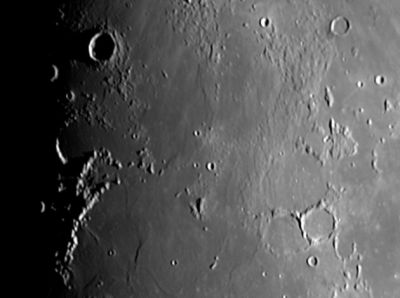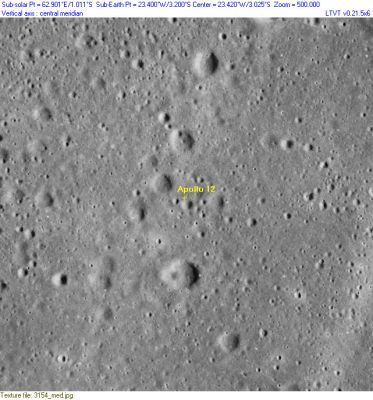Difference between revisions of "Apollo 12 Site"
| Line 7: | Line 7: | ||
|- | |- | ||
| | | | ||
| − | [http://www.lpod.org/coppermine/displayimage.php?pid=509&fullsize=1 [[Image: | + | [http://www.lpod.org/coppermine/displayimage.php?pid=509&fullsize=1 [[Image:Normal_FraMauro050218.jpg|external image normal_FraMauro050218.jpg]]]<br /> |
| | | | ||
| − | [[Image: | + | [[Image:Normal_Apollo%2012%20Landing%20Site%20overview%20-%20LO_III-154M.jpg|external image normal_Apollo%2012%20Landing%20Site%20overview%20-%20LO_III-154M.jpg]]<br /> |
|} | |} | ||
'''Left''': ''[http://lpod.org/coppermine/displayimage.php?pos=-509 Peter Lloyd]'' ([http://www.madpc.net/~peterl/Moon/Craters/FraMauro.html Annotated version]); '''Right''': [http://lpod.org/coppermine/displayimage.php?pos=-5771 LO III-154M] with landing site marked by yellow "+" near northwest rim of [[Surveyor|Surveyor]].<br /> <br /> <div id="toc"> | '''Left''': ''[http://lpod.org/coppermine/displayimage.php?pos=-509 Peter Lloyd]'' ([http://www.madpc.net/~peterl/Moon/Craters/FraMauro.html Annotated version]); '''Right''': [http://lpod.org/coppermine/displayimage.php?pos=-5771 LO III-154M] with landing site marked by yellow "+" near northwest rim of [[Surveyor|Surveyor]].<br /> <br /> <div id="toc"> | ||
Revision as of 18:43, 15 April 2018
Contents
Apollo 12 Site
(unofficial name)
|
Lat: 3.01239°S, Long: 23.42157°W, Rukl: 42 | |
Images
LPOD Photo Gallery images Lunar Orbiter Images Apollo Images
- For many additional maps and images see the Image Library of the Apollo 12 Lunar Surface Journal.
- For links to LRO images, see the Planetary Society's Apollo 12 & Surveyor 3! article.
- Surveyor crater (the belly of the Snowman; which is the location of the landing sites of Surveyor 3 and Apollo 12) is also detectable on Lunar Orbiter 3 frame LO3-137-med, of which the second "h" enlargement (LO3-137-h2) shows the Snowman (and Surveyor crater) near the lower part of the frame's right margin. Research: Danny Caes
Maps
(LAC zone 76B1) LAC map Geologic map LM map AIC map Landing site map
USGS Geologic Map of the Lansberg P Region (I-627), which shows the actual landing site of both Apollo 12 and Surveyor 3 in the left (or western) half of the map.
Description
Apollo 12 landed in Oceanus Procellarum near a crater containing the earlier U.S. lunar surface sampling craft Surveyor III. For a quick overview of the site and the objectives of the mission see the National Air and Space Museum website. For a little more depth, including the criteria that went into the site selection, see the LPI's Landing Site Overview, and James R. Zimbelman's Slide Show illustrating the site's location in relation to landmarks visible (through a telescope) from Earth. For much more detail, see the NASA-sponsored Apollo 12 Lunar Surface Journal.
Description: Wikipedia
Additional Information
- The position of the Apollo 12 landing site given in the title line is from Davies and Colvin, 2000. It is based on the position of the Apollo 12 lunar surface experiment package (ALSEP) radio transmitter, as later determined by Earth-based radio interferometry, and the assumption that the lander touched down 91 m east and 90 m south of that location. The measured ALSEP location is itself probably uncertain by at least 30 m. The earlier DMA-prepared Landing site map gave the approximate landing site position as 3.25°S, 23.4°W.
- In addition to the websites mentioned under "Description", the location of the Apollo 12 landing site is illustrated by a sequence of Lunar Orbiter images in the LPOD photo gallery: a General Overview (easily correlated with Earth-based photos, landing site marked by blue cross), a Moderate Closeup (showing location of Middle Crescent in relation to General Overview), and a Tight Closeup (showing Surveyor, Head and Bench craters). Note that the feature labeled "Crescent" in these views is really the IAU's Middle Crescent per the Nomenclature section of this page. - Jim Mosher
Nomenclature
The IAU Nomenclature includes 9 minor astronaut-named landing site feature names associated with Apollo 12 (copied from IAU Transactions XVIB):
- Crescent: Descriptive name of a row of seven craters arranged in the form of an arch west of the landing site.
- Snowman: An arrangement of five craters around the large crater in which Surveyor 3 landed. The geometry resembles the fabled and familiar "snowman" figure.
- Middle Crescent: (Sampling site) Crater in the middle of the aforementioned Crescent. Its rim was the farthest stop from the LM on the first EVA.
- Head: (Sampling site) Crater that forms the head of the aforementioned Snowman pattern.
- Bench: (Sampling site) Crater that forms the right arm to the Snowman arrangement; it displays a prominent bench which is indicative of excavation of bedrock beneath the regolith.
- Sharp-Apollo: (Sampling site) Sharp-rimmed and bright-rayed crater west of Bench; it is located on the extreme southwestern end of the sampling traverse on the second EVA.
- Halo: Small haloed crater on the south rim of the crater in which Surveyor 3 landed.
- Surveyor: (Sampling Site) The site of the Surveyor 3 landing.
- Block: Last sampling site, small crater within Surveyor crater.
Other names (see the Hi-Res close up of the Apollo 12 landing site in the Act-React Quick Map of the LROC, yellow colored nomenclature)
Bright Crater, Dos, East, Left Foot, North, Right Foot, Small, South Crater, Tri-Pt.
Five Crater Chain (a "J"-shaped chain of not-too-small craterlets near the landingsite of Apollo 12's LM Intrepid) (see comment-section in the LPOD US-1 and other signposts).
The landing site itself has no official name. - Jim Mosher
LPOD Articles
On the Moon (Surveyor 3)
Dark Halo Rocket (possible detection of Surveyor 3 descent rocket)
Trivia and Curiosities
Officially there are no color photographs of Surveyor 3 on the lunar surface. Careful investigation however reveals more than one color-Hasselblad photograph on which Surveyor 3 is seen, sitting at the eastern shadowed inner slope of Surveyor crater. These photographs are:
Magazine 46/Y:
- AS12-46-6740 shows LM Intrepid and a lot of spectral-colored catadioptric effects, with the distant Surveyor 3 at right, on the shadowed slope.
- AS12-46-6741 (rightward of 6740) shows Surveyor 3 at left.
- AS12-46-6746 shows it too.
- AS12-46-6769 is perhaps the best one of all color photographs of Surveyor 3. The bluish colored pentagon and the two bright "pseudo-suns" are catadioptric effects in the Hasselblad camera's lens-system (and NOT "floodlights in the studio").
Magazine 47/V:
- AS12-47-6948 shows Surveyor 3 a little to the right of the bluish colored catadioptric effect's lower half.
- AS12-47-6949 shows Surveyor 3 near the photograph's central cross. The Descent Stage of LM Intrepid is seen at left.
- AS12-47-6968 shows Surveyor 3 at left.
- AS12-47-6969 shows Surveyor 3 near the photograph's central cross (a little lower and to the left of it).
- AS12-47-6992 shows Surveyor 3 halfway between the central cross and the photograph's left margin.
- AS12-47-6993 shows Surveyor 3 near the photograph's central cross. The red-colored dot in the black sky (at right) is NOT an "extraterrestrial visitor", its origin is pure chemical, the cause of it is an irregularity in the photographic film.
- AS12-47-6994 shows Surveyor 3 about halfway between the central cross and the photograph's right margin. The two bright "pseudo suns" and the bluish colored "blob" are catadioptric effects in the Hasselblad camera's lens-system. Note the spectral colored "arc" at right, which is also a reflection-phenomenon inside the camera's lens-system.
- Research photographs: Danny Caes.
Surveyor 3's tan-like coloration
Note the somewhat tan-like coloration of Surveyor 3 on all of these photographs, a coloration which was also observed by the astronauts during their close-up investigation of the lander (sadly enough, they forgot to take color close-ups of it).
Descriptions of Surveyor 3's tan-coloration are online in Eric M. Jones's Apollo Lunar Surface Journal (ALSJ), and also in the book Die Mondlandung, der Menschheit Grosstes Abenteuer by Herbert J. Pichler (Verlag Fritz Molden, 1970).
- DannyCaes Feb 15, 2009
Bibliography
- Chi, P. J. et al (2011). Restoration of Apollo Magnetic Field Data: Accomplishments and Outstanding Issues – 42nd LPSC Conference (Mar), 2011.
- Dawson, M. D. et al (2011). Apollo Lunar Sample Integration into Google Moon: A New Approach to Digitization – 42nd LPSC Conference (Mar), 2011.
- Garcia, P. A. et al (2011). Restoration and PDS Archive of Apollo Lunar Rock Sample Data – 42nd LPSC Conference (Mar), 2011.
- Isaacson P. J. et al (2011). Reflectance Spectroscopy of Ilmenite: New Constraints from Apollo Sample Measurements – 42nd LPSC Conference (Mar), 2011.
- Kong, W. G. et al (2011). Ti Distribution in Grain-Size Fractions of Apollo Soils 10084 and 71501 – 42nd LPSC Conference (Mar), 2011.
- Petro, N. E. et al (2011). Digitization and Reanalysis of Apollo Surface Traverses – 42nd LPSC Conference (Mar), 2011.
- Seddio, S. M. et al (2011). Fragments of Granite in Apollo 12 Regolith: Pieces of 12013? – 42nd LPSC Conference (Mar), 2011.
- Snape, J. F. et al (2011). An Evaluation of Techniques Used in the Age and Petrologic Analysis of Apollo 12 Basalts – 42nd LPSC Conference (Mar), 2011.
- Williams, D. R. et al (2011). PDS Lunar Data Node: Restoration of Apollo Surface and Orbital Data – 42nd LPSC Conference (Mar), 2011.
- Apollo 12 Landing Site Overview
- Apollo 12 Lunar Surface Journal
- EXPLORING THE MOON; The Apollo Expeditions, by David M. Harland (Springer, 1999).

